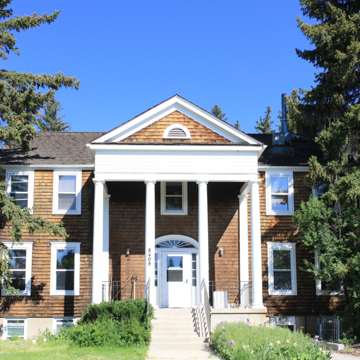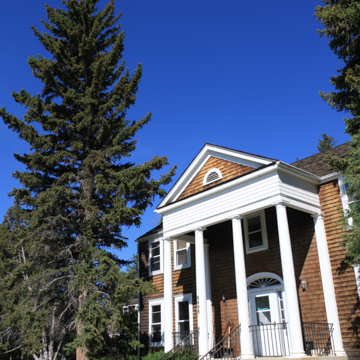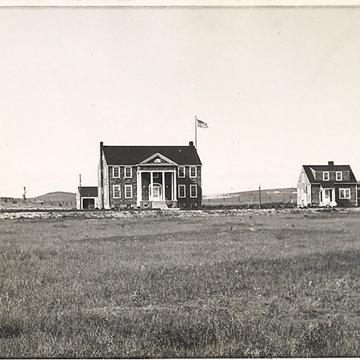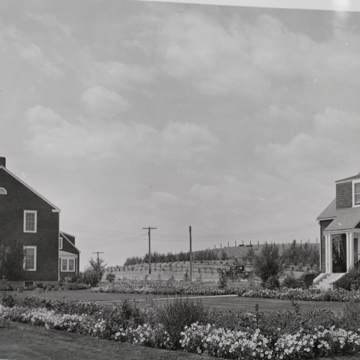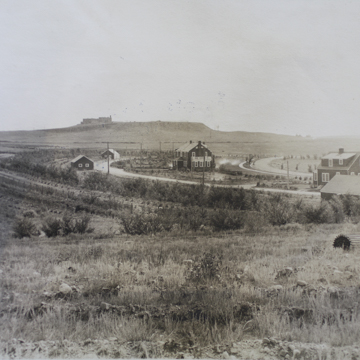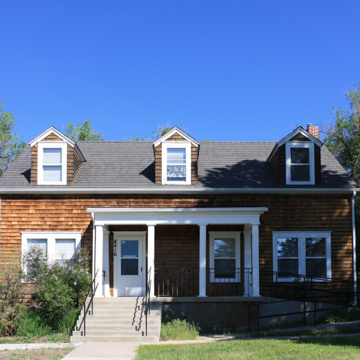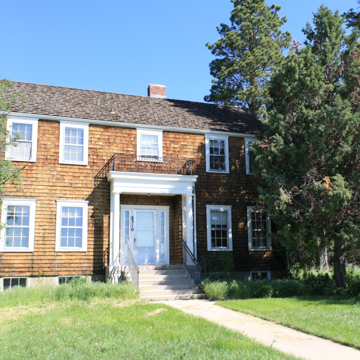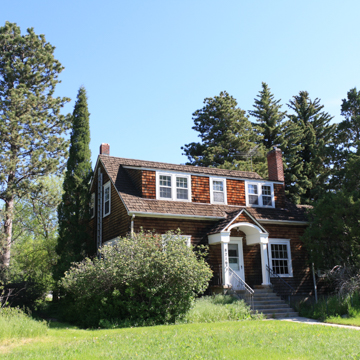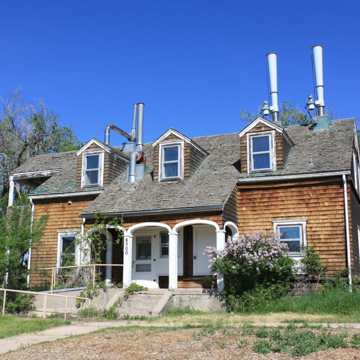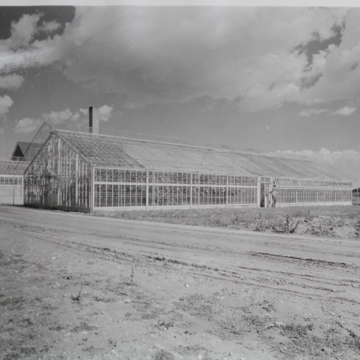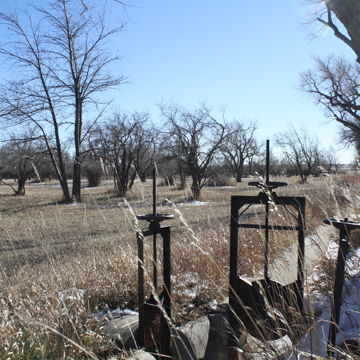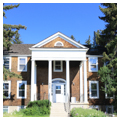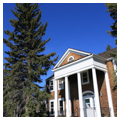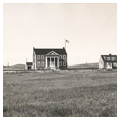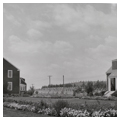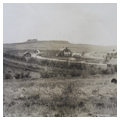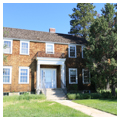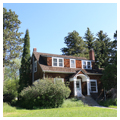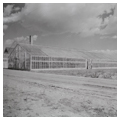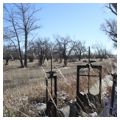You are here
High Plains Grasslands Research Station
In 1928, the U.S. government authorized the construction of the Central Great Plains Field Station in Cheyenne. The station was part of a nationwide system of agricultural experiment stations under the direction of land-grant universities, forestry divisions, and eventually the U.S. Department of Agriculture, as authorized by the Hatch Act of 1887. The station was designed to complement the other two Great Plains research stations at the time: the Northern Great Plains Field Station in Mandan, North Dakota, and the Southern Plains Field Station in Woodward, Oklahoma. The research grounds occupy a 2,873-acre site about eight miles northwest of Cheyenne. A reservoir and grasslands occupy the northern part of the site; to the south is the main building complex, surrounded by an arboretum. The landscape plan for the Field Station was developed by Denver landscape architect Saco Rienk DeBoer, while preeminent Cheyenne architect William R. Dubois designed the buildings. Early development of the station was aided by a Civilian Conservation Corps (CCC) camp of 200 men, which opened on the site in 1935. Over the next seven years, the CCC built roads, concrete-lined irrigation ditches, and a water and septic system, and planted thousands of trees and shrubs.
The site is accessed via a county road, which forms a loop at its end. The buildings are lined up along this road with the headquarters building roughly in the center, flanked by residences, and utility buildings to the south. The headquarters area is heavily planted with trees, as are fields to the south of the loop access road. Most of the horticultural research took place near, around, and inside the buildings, as well as in the fields south of the headquarters. The headquarters building, research building, the first greenhouse, office, and residences were built in 1928 and 1929, overseen by the station’s first superintendent, Robert Wilson. A plant cellar, lathe house, laboratory, and storage buildings as well as irrigation ditches were added over the next decade.
Although fitting for a federal government agency, the Colonial Revival structures are architectural anomalies on the high plains of Wyoming. The headquarters building features a two-story portico with Tuscan columns rising to a wood entablature topped by a pediment. The central doorway is framed by a fanlight and sidelights in the Federal style. Walls are finished in wood shingles. Although not as grand as the headquarters, residences are also Colonial Revival in style, with wood-shingled walls, columned porches, white-painted wood trim, and red brick chimneys. Dubois’s New England–style buildings must have been a comfort to the station’s second superintendent, Dr. A.C. Hildreth, whose previous position was serving for the Maine Agricultural Experiment Station.
In 1930, the station’s name was changed to the Cheyenne Horticultural Field Station. The station’s mission was to increase “livability” on the High Plains, particularly in southeastern Wyoming, through experimenting with fruits, vegetables, windbreaks, and ornamental plants. Because early-twentieth-century residents of the High Plains had to grow much of their own food, the Station’s work was critical to the survival of the area’s communities. Given the location of Cheyenne at 6,200 feet above sea level, with its notorious wind speeds and hail storms, it was believed that if vegetation could grow at the station, it could anywhere. Superintendent Hildreth noted the importance of the Cheyenne Horticultural Field Station to the High Plains: “Considering cold, drought, wind, hail, and shortness of growing season, this location represents about the most difficult conditions for horticultural plants on the Wyoming plains.” The Station fulfilled its mission by planting and testing more than 2,000 fruits, 1,300 varieties of ornamental plants, 200 species of trees and shrubs, and over 8,000 vegetables. Of course, many of these plants did not survive or do well enough on their own to make a feasible contribution to central Great Plains living, but an amazing number of fruits, vegetables, flowers, trees, and shrubs came to use thanks to the work of the Station’s scientists. For example, the Station developed popular strawberry varieties in use on the Plains today, such as Radiance, Ogallala, and Fort Laramie.
In the 1960s, the Station’s research extended to experimenting with potato varieties, carnations, and chrysanthemum. The Cheyenne Hardy Mum, developed at the Station, was named Cheyenne’s official flower in 1970. In 1974, in order to better serve the communities of the High Plains in the late twentieth century, the Station shifted its focus away from arboriculture and horticulture to the study of livestock, grasslands, mining reclamation, and water conservation. At this time, the name was changed to the High Plains Grasslands Research Station. Today, the Cheyenne Botanic Gardens shares the site with the U.S. Department of Agriculture, operating an arboretum in the area just south of the headquarters. The Research Station continues to play an important role in agricultural research locally, regionally, nationally, and internationally.
References
Freeman, John F. High Plains Horticulture: A History.Boulder: University of Colorado Press, 2008.
Townsend, Evan E. “An American Aesthetic: A Social History and Future for Tree Planting on Southeastern Wyoming’s High Plains.” M.A. Thesis, American Studies and Environment and Natural Resources, University of Wyoming, May 2016.
Agricultural Research Service. “Cheyenne Horticultural Field Station and the High Plains Grasslands Research Station.” U.S. Department of Agriculture, n.d.
Writing Credits
If SAH Archipedia has been useful to you, please consider supporting it.
SAH Archipedia tells the story of the United States through its buildings, landscapes, and cities. This freely available resource empowers the public with authoritative knowledge that deepens their understanding and appreciation of the built environment. But the Society of Architectural Historians, which created SAH Archipedia with University of Virginia Press, needs your support to maintain the high-caliber research, writing, photography, cartography, editing, design, and programming that make SAH Archipedia a trusted online resource available to all who value the history of place, heritage tourism, and learning.

